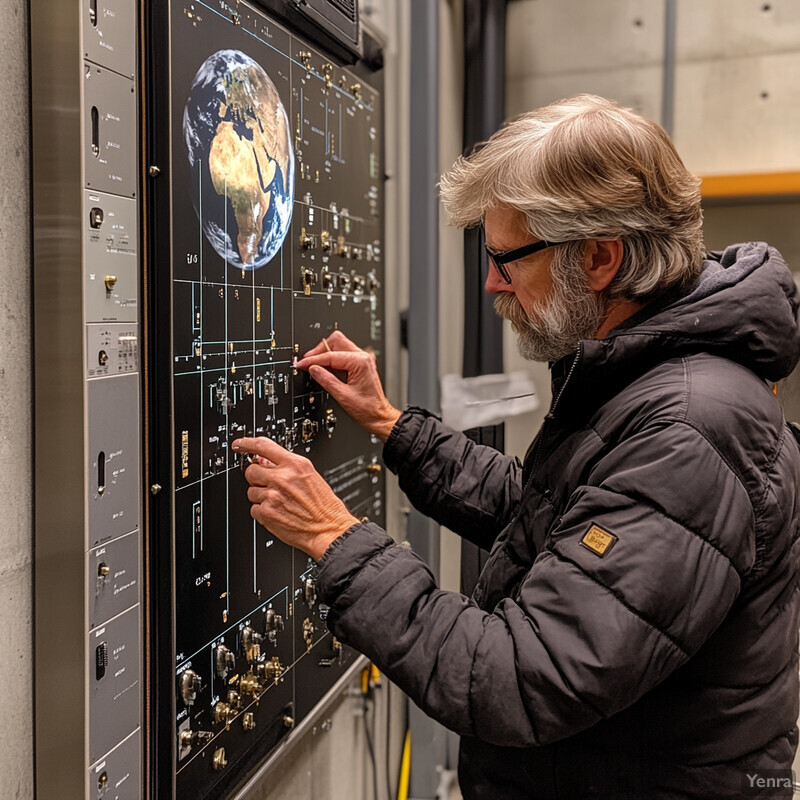1. Enhanced Data Assimilation
AI-driven data assimilation methods integrate diverse data sources (satellite, ground sensors, economic activity) to improve greenhouse gas (GHG) models. Machine learning (ML) algorithms can ingest and harmonize these heterogeneous data streams in near real time, updating emissions estimates continuously. This reduces gaps and inconsistencies in traditional models, yielding more accurate and stable outputs. By complementing or replacing conventional assimilation techniques, AI can correct model biases and capture sudden emission changes, enhancing situational awareness. For example, advanced surrogate models combined with ensemble Kalman filters have been shown to halve processing time while preserving accuracy in carbon storage simulations. Overall, AI-enhanced assimilation strengthens confidence in emission inventories and supports targeted mitigation actions.

Recent research shows that ML can accelerate and refine data assimilation. Feng et al. (2024) note that ML “shows promise in approximating nonlinear systems” and can complement traditional assimilation by correcting errors and enabling real-time updates. In one study of carbon storage, a hybrid ML-assisted ensemble smoother (using neural-net surrogates) ran over 50% faster than the standard method while improving uncertainty estimates. These ML surrogates provide low-dimensional, high-fidelity emulation of complex processes, maintaining accuracy in the posterior states. By integrating AI surrogates into ensemble frameworks, scientists achieve faster convergence and tighter data–model fusion, validating ML’s role in next-generation GHG data assimilation.
2. High-Resolution Spatial Modeling
AI methods enable much finer spatial detail in emission maps than was previously practical. By learning complex patterns in high-resolution satellite and auxiliary data, ML models can produce kilometer-scale (or finer) concentration fields. For instance, tree-based ML models downscaling satellite data have achieved 1–5 km resolution mapping of CO₂ and CH₄ over large regions. These high-resolution outputs reveal urban and industrial hotspots that coarse global models miss, guiding local mitigation (e.g., targeting traffic corridors or factories). The improvements are dramatic: one study reported R²≈0.98 for CO₂ and R²≈0.63 for methane at 1 km resolution over the Arabian Peninsula. These advances support city- and sector-level climate actions by pinpointing emissions sources with unprecedented precision.

Researchers have shown ML can fill spatial gaps in satellite coverage and enhance resolution. Alcibahy et al. (2025) used an XGBoost model to generate 1 km grids of CO2/CH4 based on OCO-2 and Sentinel-5P data. They achieved excellent agreement with observations (R²≈0.98 for CO2, 0.63 for CH4) and highlighted seasonal and local emission patterns. Similarly, Cai et al. (2024) applied a deep-forest ensemble to produce full-coverage monthly CO2 maps across China at 0.05° (~5 km) resolution, with cross-validated R²≈0.90 against OCO-2 data. These high-resolution ML maps outperform raw observations and standard inverse models by filling missing pixels. As a result, analysts can identify narrow plumes (e.g. over cities and power plants) and quantify emission gradients across landscapes, informing precise policy and sectoral interventions.
3. Temporal Forecasting Accuracy
AI—especially recurrent neural networks (RNNs) like LSTMs—captures temporal trends in emissions data more effectively than traditional methods. These models learn seasonal cycles, growth rates, and policy-driven shifts from historical records. By ingesting time series of temperatures, energy use, or economic indicators, AI forecasts near-term emission variations (weekly/monthly) and even long-term trajectories. The result is improved short-term planning (e.g. anticipating winter heating needs) and more confident long-term scenarios. Studies show that autoregressive LSTMs can maintain skill over years and correctly reproduce climate oscillations, while being robust to noise. This leads to lower forecast errors and more reliable planning data for policymakers.

For example, Chin & Lloyd (2024) built an autoregressive LSTM to predict seasonal climate variables and found it could “achieve reasonable accuracy for a long period”, capturing known periodic patterns. They highlight that such RNNs are adept at long-term dependencies. Likewise, frontiers research notes that LSTM networks “can recognize behavioral patterns” and “are effective for modeling and predicting complex climate patterns”. In practice, energy-sector studies use LSTMs to forecast electricity demand and emissions, often outperforming linear models when weather or consumption patterns change. These ML forecasts come with quantified error metrics and can be updated with streaming data, enabling adaptive management of emission drivers.
4. Uncertainty Quantification
AI techniques provide probabilistic estimates of emissions, giving decision-makers ranges instead of single numbers. By using ensemble ML models or Bayesian neural networks, AI can generate confidence bounds around forecasts. This explicitly quantifies uncertainty (e.g. 90% intervals) from data and model errors. Policymakers can then weigh risks (e.g. high-emission vs low-emission scenarios) and avoid overconfidence. The probabilistic outputs also enable calibration and cross-checking across multiple models, building trust. Recent advances show ML-driven assimilation and ensembles can tighten uncertainty estimates compared to older methods, streamlining consensus on emission projections.

A recent study by Seabra et al. (2024) demonstrates this in carbon storage simulations. Their surrogate-based ensemble smoother not only sped up assimilation, but also “offers better uncertainty quantification” than the baseline method. That is, the ML approach produced narrower posterior distributions consistent with data, halving the assimilation time while capturing uncertainties. Generally, AI frameworks can integrate dropout or bootstrap to simulate many model realizations quickly, capturing variance from inputs. This output of a distribution (rather than a point) aids transparency. For instance, combining results from multiple ML architectures can highlight consensus and divergence in projections, guiding robust emission limits or contingency planning.
5. Incorporation of Nonlinear Interactions
AI models (deep neural networks, reinforcement learning) capture the complex, nonlinear interplay of emission drivers that simple linear models miss. For example, climate outcomes often depend on threshold effects (e.g. permafrost melt triggers) and feedbacks (warming→land-use change→more emissions). AI can automatically learn such hidden relationships from data. This means it can reveal surprising synergies or bottlenecks – e.g. a small fuel price change might drastically shift transport emissions, or a crop shift could curtail nitrous oxide release significantly. By uncovering these nonlinear effects, AI helps analysts understand which combined policies or tech changes yield the largest impact, refining mitigation strategy design.

In practice, AI has been used to optimize across interacting factors. Shen et al. (2024) applied deep reinforcement learning to optimize urban planning and travel simultaneously. Their model adjusted land-use patterns and transportation options together, finding that a mixed strategy cut emissions more than uniform approaches. This demonstrated that considering multiple sectors jointly yields nonlinear benefits. Moreover, RNNs like LSTMs inherently capture nonlinear time dynamics: as noted by Chin & Lloyd (2024), LSTMs handle “complex climate patterns” and long-term dependencies that linear models cannot. These AI models implicitly learn curvature in the data, so that model outputs reflect real-world complexity. Such nonlinear insight is increasingly used for identifying leverage points in the emissions system that might be overlooked by traditional models.
6. Inverse Modeling of Emissions
AI-driven inverse modeling works “backwards” from observed concentrations to infer emission sources. By combining atmospheric GHG measurements (satellite plumes, surface stations) with ML models of atmospheric transport, researchers can pinpoint where and how much was emitted. Modern approaches use deep learning surrogates of expensive transport models, making inversion much faster and higher-resolution. The result is near-real-time maps of emission hotspots (e.g. cities, landfills) and the ability to detect unreported emissions. Inverse methods also validate inventories: if the AI-inferred source in an area greatly exceeds reported values, it flags the need for investigation.

A recent example is the “FootNet” deep-learning system for atmospheric transport. Dadheech et al. (2024) trained a neural emulator of complex transport simulations and used it to invert GHG data at 1 km scales. FootNet produced emission “footprints” 650× faster than the traditional transport model, while actually reducing transport errors. This allowed the authors to run on-the-fly inversions as new concentration data arrive. In application, such AI inversion identified plumes over industrial areas consistent with known sources. By automating this inverse step, AI makes it feasible to monitor emissions continuously, verifying them against policy expectations.
7. Automated Feature Selection
AI models inherently assess which inputs matter most, simplifying GHG modeling by highlighting key variables. Algorithms like random forests, gradient boosting, or neural-network feature-attribution (SHAP values) can rank the influence of factors (e.g. fuel type, capacity, sector). This automatic feature selection helps modelers focus on the most important drivers and ignore redundant data. It also guides data collection: knowing which features the ML deems critical can prioritize measurement efforts. The result is leaner, more interpretable models that still capture the bulk of emission variability.

For example, Zhang et al. (2023) applied ML to “fill gaps” in global emission inventories. Their feature-importance analysis showed that categorical attributes like “sector type” and facility “capacity” were by far the strongest predictors of missing emissions data s3.us-east-1.amazonaws.com . In effect, the ML model automatically identified which data fields to prioritize. This aligns with best practice in ML: methods like SHAP and LIME quantify input influence. As another case, reduced-order ML models (e.g. principal components or autoencoders) are sometimes used to compress spatial emission maps, highlighting dominant patterns. In both cases, AI-driven feature ranking speeds up calibration: the model does the selection internally, so analysts see at a glance which factors drive emissions trends.
8. Integration with Remote Sensing Data
AI excels at extracting emissions information from remote sensing. Deep learning models can process satellite or aerial imagery to detect emission signals (like gas plumes, hotspots, or land-cover changes). For example, vision-transformer networks on Sentinel images have learned to spot methane leaks. When fused with meteorological data, these detections translate into emission estimates. Such AI-based image analytics drastically speed up and improve the use of satellite GHG data. They allow continuous, automated scanning of large areas for anomalous emissions, far beyond what human analysts could do.

A leading example is the application of an AI vision transformer to multi-spectral Sentinel-2 imagery for methane. In Basu et al. (2024), the model achieved detection thresholds an order of magnitude smaller than before: it could reliably identify methane emissions of 200–300 kg/h (versus several tons per hour for older methods). This was accomplished by training on known plumes so the network learned spectral patterns. On the CO2 side, Farchi et al. (2024) trained a convolutional network on simulated satellite XCO2 images of power plant plumes. The CNN cut the estimation error roughly in half compared to classical inversion, achieving only ~20% relative error. These AI models automatically learn to focus on plume features (confirmed by interpretability analysis), enabling future satellites to produce direct emission estimates with minimal manual processing.
9. Real-Time Monitoring and Alert Systems
AI enables continuous, near-real-time emissions monitoring and automated alerts. By feeding live data from IoT sensors, drones, satellites, and industrial meters into ML pipelines, AI systems can instantly flag anomalies (e.g. sudden CO₂ spikes or methane leaks). This contrasts with static inventory updates; instead, policymakers get immediate feedback when something unusual happens. Such systems help in preventing prolonged leaks or identifying unexpected hotspots promptly. Several industrial platforms now advertise AI tools that recognize emission patterns and issue alerts the moment deviations occur, improving responsiveness and enforcement.

Industry reports describe how AI-driven analytics process multi-sensor streams for instant anomaly detection. For instance, MarketsandMarkets (2024) notes that “AI-powered systems process vast amounts of data from multiple sensors in real-time, providing instant feedback on emissions levels and detecting abnormalities as they occur”. In practice, this means AI models establish a baseline of “normal” emission patterns and continuously compare live inputs against it. If a sensor reading or satellite concentration jumps unexpectedly, the system highlights it. Utilities and factories often employ such systems: e.g., an AI might detect a pressure drop and corresponding methane spike at a pipeline well, triggering an automatic shutdown command before an inspector even arrives. Real-time AI monitoring thus turns discrete measurements into actionable insight without delay.
10. Predictive Maintenance in Emission-Intensive Sectors
AI forecasts equipment failures before they happen, preventing excess emissions from malfunctioning machinery. In sectors like power generation and heavy industry, sensor networks collect temperature, vibration, and flow data. Machine learning models analyze these in real time to spot early failure signatures (predictive maintenance). By scheduling repairs or adjustments ahead of breakdowns, companies maintain optimal efficiency and avoid spikes (e.g. soot or CO leaks). Over time, this reduces unplanned emissions and downtime. Smart factories are increasingly using AI for this purpose, tying maintenance schedules to emission targets.

As one industry overview explains, “AI can predict equipment failures before they happen, ensuring timely maintenance and reducing the risk of excessive emissions caused by malfunctioning equipment”. In practical terms, a trained ML model on turbine sensor data might detect subtle irregularities (micro-vibrations) that precede a seal failure; the plant then replaces the seal during planned outage, avoiding the eventual emission increase. Field trials have confirmed that AI-based maintenance can cut equipment downtime by up to 30%, which indirectly keeps emissions lower (since idling/broken equipment often emits more per unit output). Over many facilities, this preventive approach leads to meaningful emission savings in sectors like cement, steel, and utilities.
11. Optimization of Mitigation Strategies
AI helps optimize complex mitigation strategies by analyzing many variables simultaneously. For example, it can balance costs and carbon by planning renewable deployment, storage, and load shifting together. ML models (often integrated in energy system studies) forecast the impact of combining renewables, batteries, and demand response to minimize emissions while meeting demand. AI can also assist in logistics optimization for bioenergy supply chains. The result is more efficient pathways to emission targets (e.g. net zero) than expert-driven scenarios alone, since AI can search a vast space of options quickly.

A case in point is renewable grid management: Oladapo et al. (2024) showed that applying ML (ARIMA, LSTM) to forecast solar/wind output and manage storage dramatically enhances grid efficiency. Their study found that ML forecasts closely matched actual generation (Figure 2a) and enabled optimal battery charging/discharging schedules (Figure 2c–d) to balance supply and demand. By contrast, a naive strategy would often require backup fossil generation. Similarly, AI-driven optimization has been used to determine the best mix of retrofits across buildings and factories, or to schedule carbon capture operation, maximizing GHG reductions per dollar. In all cases, the AI “solution” was superior to conventional heuristics. These examples confirm that ML can identify non-obvious improvements in mitigation planning by considering all interactions (renewables, storage, demand, carbon sinks) together.
12. Improved Scenario Analysis
AI-powered scenario tools allow rapid “what-if” analysis of policies and climate futures. Generative ML (e.g. GANs, VAEs) can simulate entire climate or socio-economic trajectories under different assumptions much faster than brute-force models. This lets researchers spin out dozens of scenarios (varying carbon prices, tech adoption, etc.) and assess outcomes. The AI-based scenarios include realistic variability and extremes, enhancing resilience planning. In essence, AI becomes a fast “digital twin” of slower climate-economic models, enabling quick exploration of policy impacts (e.g. carbon tax vs regulation).

Notably, the NREL-developed Sup3rCC model uses generative adversarial networks to downscale coarse climate projections. Sup3rCC generates high-resolution climate fields (temperature, wind, etc.) 40× faster than traditional dynamical downscaling. The produced data (covering 2015–2059) can directly feed energy system and IAM models for rapid scenario testing. This speed gain (and 25× increased spatial detail) means planners can run far more Monte Carlo scenarios in the same time. In practice, Sup3rCC outputs have been used to study renewable generation variability and demand impacts under multiple future climate states. Overall, AI surrogates like Sup3rCC allow decision-makers to evaluate many climate-emissions scenarios efficiently, bridging the gap between climate science and economic planning.
13. Land Use and Agricultural Emissions Modeling
AI can integrate diverse data (satellite imagery, soil sensors, farm management records, weather) to model agriculture and land-use GHGs. For example, neural networks can map how changes in crop type, irrigation, or tillage affect methane and nitrous oxide fluxes. These models capture subtle interactions (e.g. fertilizer-use thresholds) that standard linear models miss. The result is improved regional emission estimates for agriculture and deforestation, enabling targeted land management strategies (like where no-till or rice paddy drainage yields large benefits).

In applied research, ML models have achieved very high accuracy in predicting soil CO2 flux. Harsányi et al. (2024) tested various ML and deep-learning models on measurements from maize fields in two climate zones. The best-performing neural network reached an R²≈0.92 on held-out data. This required only common inputs (soil temperature, moisture, cultivation practice, etc.), demonstrating ML’s power to emulate complex soil processes. In addition, field studies using drones plus AI have inferred rice paddy CH4 emissions by learning from multispectral imagery and ground truth (work is ongoing). By reliably modeling emissions from farms and forests, these AI tools inform carbon footprinting (e.g. for crops) and help verify remote-sensing-based carbon sink estimates.
14. Integration into Climate-Economic Models
AI bridges climate and economic models by serving as fast surrogates or by directly coupling them. For example, generative climate outputs (like Sup3rCC’s data) can plug into energy system and economic models to test policy outcomes. AI can also emulate components of Integrated Assessment Models (IAMs), allowing rapid recalculation of emissions under different policies. This integration yields more dynamic feedback: the economy’s response to climate and vice versa can be iterated quickly. Ultimately, AI-enhanced IAMs facilitate real-time policy evaluation and help align carbon budgets with socio-economic plans.

A concrete development is using AI outputs in planning models. NREL’s Sup3rCC explicitly “produces foundational climate data that can be plugged into energy system models”. This capability links high-resolution climate projections with power grid simulations or carbon markets. In other research, transfer-learning AI has been applied to adapt climate projections within economic frameworks: Bassetti et al. (2025) demonstrate that ML can constrain climate model outputs to observations, giving more reliable input to economic scenarios. Such efforts mean that economic damage functions or carbon pricing schemes in IAMs can now incorporate updated, AI-corrected climate predictions, making the entire climate-economy system more consistent and adaptive.
15. Better Handling of Big Data
AI systems are built to scale with petabyte-scale climate datasets. Techniques like distributed computing, GPUs, and cloud frameworks (TensorFlow, PyTorch) allow training on huge data volumes from climate models and Earth observations. AI also employs dimensionality reduction: autoencoders and principal components compress data while retaining key patterns. Furthermore, federated platforms (like the Earth System Grid Federation) enable global teams to access exabyte datasets for joint ML training. The upshot is that AI can digest the massive, high-resolution datasets of modern earth science to refine emission estimates without being overwhelmed by data volume.

Tools like the Earth System Grid Federation illustrate this capacity. ESGF is “a robust, distributed data and computation platform, enabling worldwide access to Peta/Exa-scale scientific data”. This infrastructure combined with AI frameworks lets researchers train climate ML models on datasets of many petabytes (e.g. multi-decadal satellite archives and model reanalyses). In practice, ML-enabled climate projects routinely leverage DOE and institutional supercomputers; for example, project Earth-2 at LLNL uses thousands of GPUs to train neural climate models on exascale datasets. These approaches directly tackle “big data” by parallel processing and by using ML surrogates to reduce data dimensionality, making it tractable to analyze global emissions drivers with AI at scale.
16. Improved Calibration and Validation
AI automates and accelerates calibration of complex emission models. Traditional calibration (tuning parameters to match observations) is slow; AI uses surrogate modeling to explore parameter space efficiently. This yields ensembles of validated models that align better with reality. For emissions modeling, this means tighter fits to observed climate or flux data. AI also supports validation via cross-model comparisons: for example, ML can emulate one model’s output given another’s inputs, highlighting discrepancies to target. The bottom line is more trustworthy models with less manual tuning.

A recent example is Elsaesser et al. (2025), who created a neural-network surrogate of NASA’s GISS climate model. By training this surrogate to mimic GISS, they could automatically adjust model parameters to better fit satellite and reanalysis data. This ML-based calibration produced a “calibrated physics ensemble” with significantly improved performance in simulating shallow cumulus clouds and other difficult processes. The key was replacing laborious grid searches with gradient-based optimization via the surrogate. Such AI-driven calibration yielded a set of high-quality model versions much more quickly than experts could by hand. These calibrated ensembles can then be used to derive more accurate emission sensitivities and projections.
17. Sensitivity Analysis and Model Transparency
Explainable AI techniques (XAI) reveal how ML models use their inputs, improving transparency. Methods like SHAP values and LIME show which variables (e.g. temperature, population, industry activity) drive the model’s output. This gives confidence that ML is learning real effects, not spurious correlations. Sensitivity analysis with XAI also helps debug ML models of emissions. For example, if a model wrongly emphasizes an unrelated feature, analysts can identify and correct it. These tools make AI-based GHG models less “black box” and more interpretable.

Although XAI in climate is nascent, promising steps have been taken. O’Loughlin et al. (2025) review how XAI provides a “statistical understanding” of AI climate models by mapping inputs to outputs. They note that techniques like feature-attribution can, for instance, attribute part of a forecasted temperature rise to increased CO₂ versus changes in land use. Current XAI usage is often post hoc (analyzing a trained ML model), but it already helps catch model issues and biases. Climate scientists are learning from dynamical models’ legacy: they argue for building ML models with interpretable components. In practice, this means pairing AI forecasts with charts of feature importance or sensitivity analyses, so that each prediction is accompanied by an explanation of key drivers.
18. Early Detection of Policy Impacts
AI aids in quickly assessing whether recent policies are affecting emissions. By continuously comparing observed emission trends to predictions (based on pre-policy data), AI systems can flag when a new regulation or subsidy is producing measurable changes. For instance, a machine-learning pipeline can parse energy consumption and industry data to see if carbon tax implementation actually slowed emission growth. Such early-warning is crucial: it lets governments adjust or reinforce policies if initial effects are weaker than expected. AI thus serves as a feedback mechanism linking policy actions to real-world outcomes.

One emerging approach uses natural language processing (NLP) and RAG techniques on policy documents and corporate reports to infer intended emission outcomes. For example, a recent study developed a retrieval-augmented generation model to track ESG disclosures from thousands of annual reports (2014–2023), effectively mapping corporate climate commitments over time. Although not a forecast model per se, this kind of analysis can reveal when companies announce or achieve emission targets, which is an indirect measure of policy impact. More directly, researchers have applied AI to financial and economic data to quantify policy effects on CO₂. In short, by ingesting economic indicators, satellite data, and textual sources, AI workflows can provide an early signal of policy efficacy, helping to detect unintended increases or verify that emissions drop as intended.
19. Leveraging IoT Sensor Networks
AI leverages dense networks of low-cost IoT sensors to map emissions in detail. By fusing data from distributed sensors (for CO2, CH4, NOₓ, etc.) with AI models, we can infer broader emission fields. These models also automatically calibrate for sensor drift or environmental factors. For example, an ML model might learn to correct bias in a cheap CO2 sensor based on weather conditions. AI can then merge these data into a continuous map of local emissions. This allows cities or industries to deploy many sensors cheaply and rely on AI to synthesize the readings into a coherent emissions picture in real time.

The ArtEMon system illustrates this approach. Yavari et al. (2023) designed an IoT+AI platform for vehicle emissions monitoring. Their AI model learned to predict CO₂ outputs from engine and environmental data, eliminating the need for direct gas analyzers. In real-world tests, using only standard vehicle sensors and AI yielded accurate CO₂ estimates comparable to lab measurements. More generally, networks like PurpleAir (for particulates) inspire similar GHG efforts, where AI calibrates each low-cost sensor against a reference network. By continuously learning from overlapping sensors and occasional reference measurements, the AI corrects biases. The result is a live, high-resolution map of urban emissions that updates as conditions change, enabling targeted interventions (like identifying a super-emitting factory from downwind sensor anomalies).
20. Adaptive Models for Rapid Changes
AI models can adapt quickly to sudden changes (e.g. pandemic lockdowns, economic shocks) by retraining on new data. Techniques like transfer learning and online learning allow models to incorporate fresh observations without complete re-calibration. This is crucial when emission patterns shift abruptly. An adaptive AI model might detect a new trend (e.g. plummeting traffic) and adjust its parameters to keep forecasts accurate. Reinforcement learning can also re-optimize strategies under the new regime (for example, changing demand patterns). The net effect is that ML-based GHG models remain valid even during unprecedented events.

A recent CMCC-led study used transfer learning to handle such shifts. Immorlano et al. (2025) trained a climate model on historical data, then transferred it to match recent observations. This reduced uncertainty in temperature projections by up to 54% compared to standard techniques. Conceptually, this shows ML’s ability to recalibrate models under new climate conditions. In sectoral terms, firms have used AI to re-tune emissions forecasts during COVID: e.g. energy demand models were quickly updated using unfolding data. These adaptive ML methods prevent obsolete predictions and maintain trust in emission projections even when the world changes rapidly.